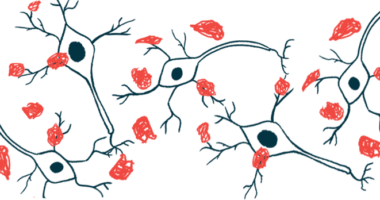Early, late FAP stages distinguished with noninvasive nerve fiber test
Motor, sensory axonal excitability changes seen with disease progression

A noninvasive test that measures axonal excitability, or the processes that underlie electrical impulses along nerve fibers, could distinguish between the early and later stages of familial amyloid polyneuropathy (FAP), a study reports.
“Axonal excitability has utility to identify early and progressive nerve dysfunction in [FAP],” the researchers wrote in “Axonal excitability as an early biomarker of nerve involvement in hereditary transthyretin amyloidosis,” which was published in Clinical Neurophysiology.
FAP is an inherited, progressive disorder caused by the harmful buildup of a misfolded form of the protein transthyretin, which mainly causes nerve damage, or neuropathy.
Early FAP symptoms include abnormal sensations in the hands and feet, such as numbness, burning, or tingling, caused by damage to small nerve fibers. The disease can then progress to larger nerve fibers, impairing the ability to feel vibrations and perceive movement and affecting balance and coordination.
Nerve conduction velocity tests that measure the ability of a nerve fiber, or axon, to transmit an electrical signal to other areas of the body are among the tools used to diagnose FAP. By the time these tests detect nerve dysfunction, however, a substantial number of axons have already been damaged. For this reason, earlier biomarkers of nerve involvement and axonal dysfunction in FAP could help monitor nerve outcomes in clinical trials and support developing therapies to prevent more extensive nerve damage.
Axonal excitability assesses the processes that underlie nerve impulses, namely the function of axonal membranes and ion channels.
Before a nerve impulse, the axonal membrane is polarized, meaning there’s a positive electrical charge outside the membrane relative to a negative charge inside. When stimulated, the nerve impulse propagates along the axon due to the sequential opening of membrane protein channels that let positively charged sodium ions flow inside the axon, which depolarizes, or neutralizes, the membrane. The impulse is immediately followed by the outward flow of positively charged potassium ions that re-polarizes, or resets, the membrane.
Testing when dysfunction occurs in large nerve fibers
Here, a research team led by scientists in Australia applied axonal excitability studies to test the hypothesis that ion channel dysfunction in large nerve fibers occurs early in FAP, before large fiber damage develops.
“Improved understanding of the [underlying mechanisms] of neuropathy in [FAP] could provide early biomarkers of large [fiber] neuropathy, and markers of progression, which could have the potential for use in monitoring nerve outcomes in treatment trials,” wrote the researchers, who studied 22 FAP patients (16 men, six women; ages 26-79) and 21 age- and sex-matched healthy adults who underwent axonal excitability studies on the ulnar nerve. This nerve transmits motor impulses to muscles in the forearm and hand, along with sensory signals from the fourth and fifth fingers (ring and little fingers), part of the palm, and the underside of the forearm.
According to the symptoms, 12 patients had large nerve fiber sensorimotor neuropathy or only sensory neuropathy (late-stage FAP), and the remaining 10 had small fiber neuropathy or no overt symptoms (early FAP).
An electrode was placed at the base of the participants’ wrist to stimulate the ulnar nerve. Motor excitability studies were recorded from a hand muscle and sensory studies were recorded from fingers.
Compared with the healthy adults, FAP patients showed a slower compound muscle action potential (CMAP) latency, the time it takes for the nerve impulse to reach the muscle along a motor axon.
Further experiments indicated a progressive reduction in the stimulation threshold needed to create excess membrane polarization, or hyperpolarization, suggesting the axonal membrane is depolarized in FAP patients.
Those with signs of large fiber neuropathy showed a prolonged CMAP latency and a significantly reduced CMAP amplitude relative to the early-stage group, indicating axonal loss. There was also evidence of a reduced hyperpolarizing threshold in the large fiber neuropathy group.
In the ulnar sensory nerves, there was a significant reduction in the mean peak response in FAP patients compared with the healthy adults, which was even more pronounced in the large fiber neuropathy group.
The FAP group also showed lower levels of subexcitability — wherein the nerve needs more stimulation to generate an impulse — was significantly reduced, particularly among the large fiber neuropathy group. This suggested a reduced repolarizing potassium flow, which promotes sensory hyperexcitability, tingling, numbness, and pain, the researchers said.
No motor or sensory excitability parameter differences were seen across different FAP-causing genetic mutations.
A statistical analysis showed that abnormal measures of axonal excitability were significantly associated with FAP stage and Neuropathy Impairment Score lower limb subscale (NIS-LL).
“A continuum of motor and sensory axonal excitability changes are observed with disease progression in [FAP],” the researchers wrote. “Our results provide evidence that both sensory and motor ulnar nerve excitability can be used as potential noninvasive biomarkers of [FAP] and of early peripheral nerve involvement. This technique shows promise for use in clinical trials as measures of progression and therapeutic effect.”







